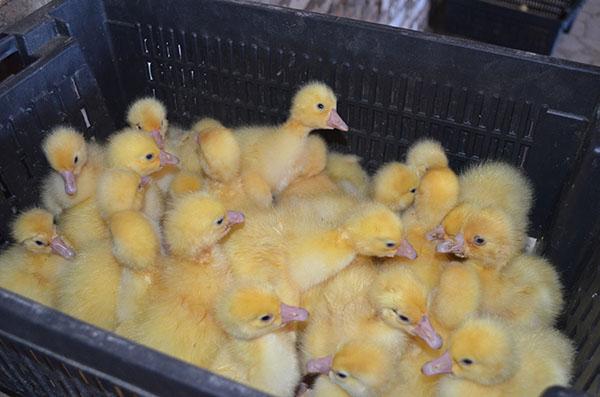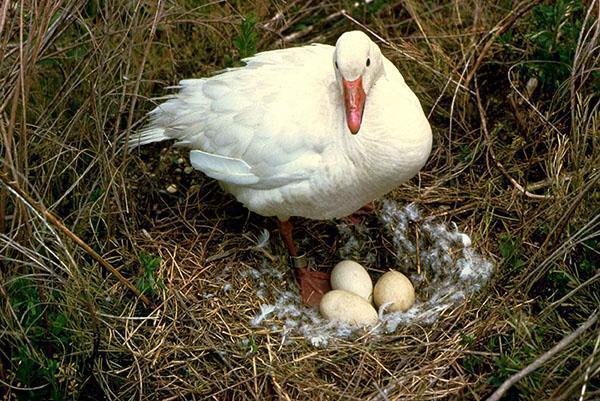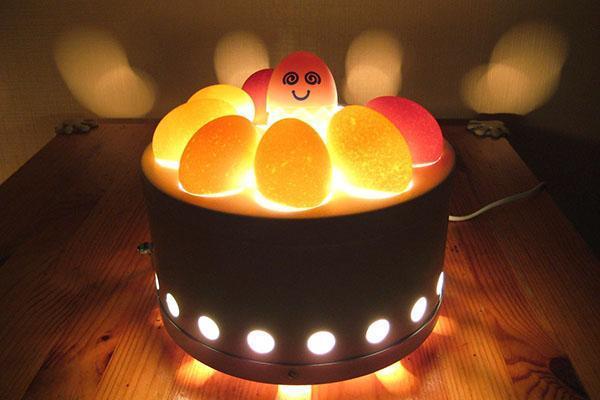Artificially hatching goslings in an incubator at home
 Breeding goslings in an incubator at home is considered a profitable and interesting business. A birdbreaker will be able to sell meat and provide a useful product for his family. Goose eggs, which can be eaten, are also highly valued. They have a beneficial effect on the work of the brain, perfectly saturate the body and are rich in vitamins A, B, B, K. Breeding goslings in an incubator and then keeping birds is not a difficult task. It is enough to know the basic rules and recommendations for the cultivation process to go smoothly.
Breeding goslings in an incubator at home is considered a profitable and interesting business. A birdbreaker will be able to sell meat and provide a useful product for his family. Goose eggs, which can be eaten, are also highly valued. They have a beneficial effect on the work of the brain, perfectly saturate the body and are rich in vitamins A, B, B, K. Breeding goslings in an incubator and then keeping birds is not a difficult task. It is enough to know the basic rules and recommendations for the cultivation process to go smoothly.
Read an article about: temperature regime when incubating chicken eggs!
Selection of eggs for incubation

Incubation of goslings will be successful if good eggs are selected in advance. An ovoscope will be useful for this. With its help, you can determine how high-quality a copy is. Eggs that are too small or large, or eggs with cracks or other defects in the shell, should be weeded out before testing.
 When using the ovoscope, pay attention to the following:
When using the ovoscope, pay attention to the following:
- the yolk should be strictly in the center;
- the protein should not contain dark spots;
- When turning, the yolk automatically returns to the correct position.
If you keep the birds yourself and plan to take eggs from them to steam the goslings in the incubator, you can affect the quality of the specimens. To do this, feed adults with a balanced food, correctly calculate the number of males and females, take geese out to pasture every day. In this case, most of the eggs will be of good quality.
How to hatch goslings in an incubator?
Eggs should not be stored for more than 7 days before being placed in the incubator. Geese rush every other day, so you have to wait until a sufficient number of specimens are collected. The storage temperature should be 10-15 °, and the eggs lie only on their side with a blunt end up. In order for the embryos not to die, they should be turned over to the other side after 4 days. If stored for longer than a week, the chance of getting live and healthy chicks is significantly reduced.
 Breeding goslings at home is carried out according to certain rules. They should not be violated, since the number of surviving and healthy chicks depends on this. If you have to grow artificially for the first time, you need to familiarize yourself with the process in detail.
Breeding goslings at home is carried out according to certain rules. They should not be violated, since the number of surviving and healthy chicks depends on this. If you have to grow artificially for the first time, you need to familiarize yourself with the process in detail.
Basic rules of incubation:
- Maintain the correct temperature. In the first days, 38 degrees, and then until the end of incubation, the temperature is reduced to 37 degrees.
- Monitor humidity levels. There must be constant water in the special grooves.
- Turn the eggs 180 degrees in time, placing the egg with the blunt end up.
The question of how goslings are bred in an incubator is quite simple to answer. The scheme of actions is always the same, and it is suitable for every person. Before laying, rinse the eggs in a weak solution of potassium permanganate in order to disinfect them. Place in liquid for 3 minutes a couple of hours before bookmarking.To prepare the solution, mix 5-7 crystals of potassium permanganate in 1 liter of water, the temperature of which is 30 °. The amount of solution can be increased while maintaining the indicated proportions. After the eggs have been washed, they cannot be wiped off with a cloth. You need to let them dry on their own so as not to break the protective shell.
 Place the picked eggs in the incubator on the wire rack. You need to put them on one side and nothing else. The first week you need to maintain a temperature of 38 °, it should not rise above. Use an outdoor thermometer to monitor the temperature. To hatch goslings in an incubator at home, spray the eggs for the first 7 days, and then do not spray for a week. Spray again from day 15
Place the picked eggs in the incubator on the wire rack. You need to put them on one side and nothing else. The first week you need to maintain a temperature of 38 °, it should not rise above. Use an outdoor thermometer to monitor the temperature. To hatch goslings in an incubator at home, spray the eggs for the first 7 days, and then do not spray for a week. Spray again from day 15
You should immediately mark the shell with a simple pencil, signing the date of the bookmark on it. This is necessary in order to know when they will approximately hatch. It is especially useful if one or more bookmarks will be added later. Mark the top with the letter B, and the bottom with H, which will help not to get confused when turning the eggs.
It is necessary to turn the eggs at least three times a day so that the embryo does not adhere to the wall. Do this at regular intervals. It is important to perform the action quickly so that the eggs do not have time to cool. If the incubator has an auto-flip function, it is recommended to set the frequency to 4 hours. It is important to remember that from the 26th day of incubation, eggs do not need to be turned over.
The eggs are not refrigerated for the first 10 days. Then, once a day, turn off the incubator and open the lid for 5-10 minutes. In the second half of the incubation, the cooling time is increased to 20-30 minutes, performing procedure 2 in the morning and evening.
Thus, you need to continue to evaporate the goslings. As for the temperature, it should remain at around 37.8 °. You should start sprinkling the eggs with warm water, doing this once a day (you can use a weak solution of potassium permanganate). Experienced breeders recommend adding 5 drops of vinegar per glass of water to the water. This is necessary in order to soften the shell. It is advisable to cool the embryos immediately after spraying for 20 minutes.
The first check and rejection of eggs is done on the 10th day of incubation. On day 21, you need to check the fetus again with an ovoscope. The contents of the egg should be dark, the gap can only be at the blunt end. The boundaries of the air chamber are uneven. If the embryo died, it will appear as a dark spot without blood vessels. In this case, the egg should be removed to make room for better heating.
 At about day 28, you need to take out the eggs, lay a piece of cloth on the wire rack so that the babies do not damage their legs. Open the special vents on the incubator lid. The chicks will begin to hatch very soon, and you need to prepare for this. Reduce the temperature to 37 °, and raise the humidity to 90%. Spray with potassium permanganate every 6 hours. There were cases when chicks appeared earlier than a month. Therefore, how many days the goslings are hatched in the incubator is a moot point.
At about day 28, you need to take out the eggs, lay a piece of cloth on the wire rack so that the babies do not damage their legs. Open the special vents on the incubator lid. The chicks will begin to hatch very soon, and you need to prepare for this. Reduce the temperature to 37 °, and raise the humidity to 90%. Spray with potassium permanganate every 6 hours. There were cases when chicks appeared earlier than a month. Therefore, how many days the goslings are hatched in the incubator is a moot point.
How long will the chicks take to hatch?
You can often hear the question of how many days to breed goslings at home. It is usually asked by novice poultry farmers. The term is individual for each case. But on average, they appear no earlier than after 28 days and no later than after 31. Chicks from small eggs break the shell first, and then the rest. If problems arise with incubation, and one of the babies cannot crawl out into the light on its own, human intervention will be required. You need to start helping in a day from the beginning of biting.
How goslings hatch
 It will be useful for every novice poultry breeder to watch a video of how goslings hatch in an incubator. It will help you better understand the process and in the future feel more confident when babies begin to hatch. At the end of the incubation period, the chicks begin to actively knock on the shell. You just have to listen. If in doubt, hold the egg to your ear.
It will be useful for every novice poultry breeder to watch a video of how goslings hatch in an incubator. It will help you better understand the process and in the future feel more confident when babies begin to hatch. At the end of the incubation period, the chicks begin to actively knock on the shell. You just have to listen. If in doubt, hold the egg to your ear.
The following can be said about the withdrawal of goslings in an incubator at home.It was successful if the chicks themselves began to hatch on 28-30 days. This can take from an hour to a day. If the process is delayed, you need to help the baby hatch. You can only release it if the shell is bled, otherwise the chick will die.
If a person approached the breeding of goslings responsibly, then it will end successfully. Most of the chicks will hatch and you can start looking after them.